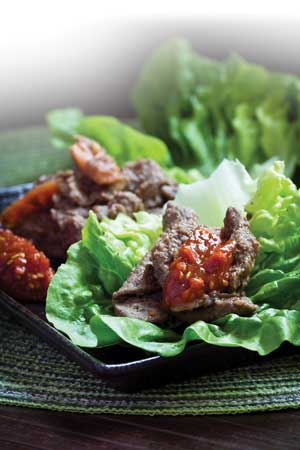Ready Set Gochujang
GLOBAL INSIGHTS
 In doing research for this month’s Ingredients column about Asian ingredients and cuisine, experts mentioned one ingredient in particular as having potential in culinary and packaged goods applications. You may have even noticed it: a thick red paste sold in plastic containers at the grocery store. That’s gochujang, an intensely flavored condiment made from glutinous rice, fermented soybeans, chili peppers, and salt (and sometimes a sweetener) widely used in Korean cuisine. “Although Korean cuisine is very popular right now with foodies, this is one of the flavors that may get the uninitiated interested in this cuisine,” remarks Chris Warsow, corporate executive chef at Bell Flavors & Fragrances, Northbrook, Ill. (bellff.com).
In doing research for this month’s Ingredients column about Asian ingredients and cuisine, experts mentioned one ingredient in particular as having potential in culinary and packaged goods applications. You may have even noticed it: a thick red paste sold in plastic containers at the grocery store. That’s gochujang, an intensely flavored condiment made from glutinous rice, fermented soybeans, chili peppers, and salt (and sometimes a sweetener) widely used in Korean cuisine. “Although Korean cuisine is very popular right now with foodies, this is one of the flavors that may get the uninitiated interested in this cuisine,” remarks Chris Warsow, corporate executive chef at Bell Flavors & Fragrances, Northbrook, Ill. (bellff.com).
Sriracha, another spicy Asian sauce that has gained mass appeal in recent years, has turned up in ketchup, snack foods, and even beer (Rogue Ales has brewed Rogue Sriracha Hot Stout Beer made with the Huy Fong brand of sriracha). Can gochujang be far behind? Chefs are already experimenting with different ways to incorporate the condiment in dishes while ingredient manufacturers are developing gochujang ingredients for use in packaged goods. Frank Dominguez, corporate chef at Smithfield Foods, Smithfield, Va. (smithfieldfoods.com), says that gochujang is making an impact in recipes as a marinade and ingredient in sauces. He has used gochujang in a marinade for pork ribs prior to smoking them and developed a BBQ sauce by blending gochujang and sriracha for a pungent, spicy glaze that pairs well with pork (the company is the top U.S. producer of packaged pork products). One of the newest ingredients introduced by Woodland Foods, Waukegan, Ill. (woodlandfoods.com), is a gochujang powder. The shelf-stable ingredient allows product developers to add the pungent flavor of gochujang to hummus and other dips and spreads, salad dressings, breading and batter, and seasoning blends and rubs.
As Michael Harlan Turkell, cookbook photographer, author, and moderator of a session at the Culinary Institute of America’s 2015 Worlds of Flavor Conference on Asia and the Theater of World Menus explained, there are different iterations of gochujang; it is not just one sauce like ketchup. To demonstrate this, Hee Kyung Lucia Cho, owner of Bicena and Gaon restaurants in Seoul, Korea, and Ki Su Bang, executive chef at Bicena, presented three different sauces based on gochujang. The first was a vinegar-based gochujang made with vinegar, gochujang, sugar, lemon juice, garlic juice, ginger puree, and simple syrup that can be used with raw fish in sushi in place of soy sauce, said Cho. The second was a thick paste created by adding soybean paste to the gochujang along with barley, chopped garlic, honey, and sesame oil. Cho said that this paste is particularly delicious in lettuce wraps. The final sauce was made by sautéing garlic, scallion, chopped protein, soy sauce, sesame oil, chopped pine nuts, and gochujang. This version may be used in bibimbap (rice with other ingredients for a one-dish meal), stews, and stir-fry.
 Karen Nachay,
Karen Nachay,
Senior Associate Editor
[email protected]
